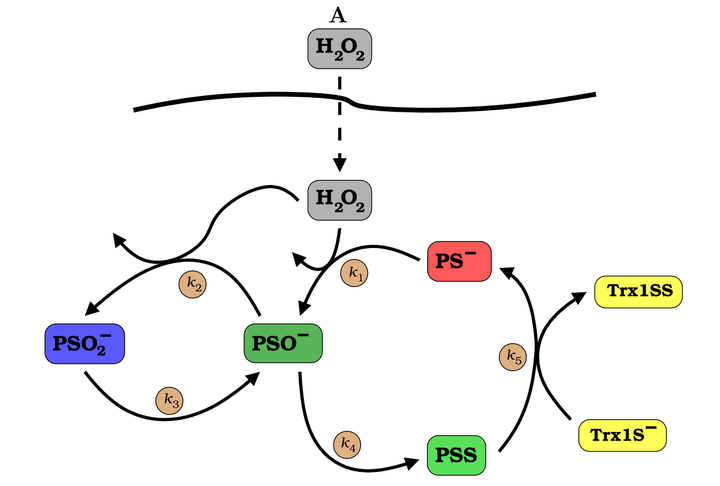
Abstract
Hydrogen peroxide (H2O2) is a key signaling agent. Its best characterized signaling actions in mammalian cells involve the early oxidation of thiols in cytoplasmic phosphatases, kinases and transcription factors. However, these redox targets are orders of magnitude less H2O2-reactive and abundant than cytoplasmic peroxiredoxins. How can they be oxidized in a signaling time frame? Here we investigate this question using computational reaction-diffusion models of H2O2 signaling. The results show that at H2O2 supply rates commensurate with mitogenic signaling a H2O2 concentration gradient with a length scale of a few tenths of μm is established. Even near the supply sites H2O2 concentrations are far too low to oxidize typical targets in an early mitogenic signaling time frame. Furthermore, any inhibition of the peroxiredoxin or increase in H2O2 supply able to drastically increase the local H2O2 concentration would collapse the concentration gradient and/or cause an extensive oxidation of the peroxiredoxins I and II, inconsistent with experimental observations. In turn, the local concentrations of peroxiredoxin sulfenate and disulfide forms exceed those of H2O2 by several orders of magnitude. Redox targets reacting with these forms at rate constants much lower than that for, say, thioredoxin could be oxidized within seconds. Moreover, the spatial distribution of the concentrations of these peroxiredoxin forms allows them to reach targets within 1 μm from the H2O2 sites while maintaining signaling localized. The recruitment of peroxiredoxins to specific sites such as caveolae can dramatically increase the local concentrations of the sulfenic and disulfide forms, thus further helping these species to outcompete H2O2 for the oxidation of redox targets. Altogether, these results suggest that H2O2 signaling is mediated by localized redox relays whereby peroxiredoxins are oxidized to sulfenate and disulfide forms at H2O2 supply sites and these forms in turn oxidize the redox targets near these sites.